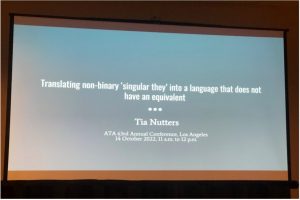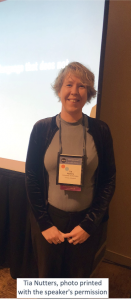By Mery Molenaar

It’s Friday morning, October 14, 2022, and I am on my way to attend a presentation by Tia Nutters on translating “singular they.” For years, I have been struggling to find a proper translation of this gender-neutral pronoun in Dutch, and I am excited to learn more from an expert in the field.
Tia works in the Netherlands as grant advisor and lecturer in translation studies at the University of Groningen (RUG) and lecturer at Utrecht University. She is also the 2022 Distinguished Speaker for the Dutch Language Division at ATA63.
In this presentation, Tia discusses how Lette Vos, the Dutch translator of Bernardine Evaristo’s 2019 Booker Prize-winning book Girl, Woman, Other translates the English non-binary pronoun “singular they” into Dutch. In the novel, Morgan, born as Megan, is referred to as they/their/them. Since Dutch doesn’t have a common non-binary pronoun, the translator obviously faced a tough problem.
Girl, Woman, Other
The story begins on October 25, 2020. At that time, Meisje, vrouw, anders, the Dutch translation of the book Girl, Woman, Other, had just been submitted to the publisher. After reading the English version of the book, Tia became curious how the pronoun “singular they” had been translated into Dutch. After finding out that Lette Vos is the translator, Tia decides to contact her, and ask her which different options she had considered and what sources she had used. Within twelve minutes Lette replies that she used hen/hun and made her decision after conducting online research at sites such as Transvisie.nl and Transgendernetwerk.nl.
Tia continues her presentation, showing two slides with an excerpt from Chapter 4, both the English source text and the Dutch equivalent. She explains that Lette based her translations on the results from a 2016 contest conducted by Transgender Network Nederland (TNN). In this contest, members were asked to list their favorite non-binary pronouns. Results showed that hen/hun (they/them) was the most popular pronoun set, while die/hen was an acceptable alternative.
Using a literal translation of “they” would present a small problem in Dutch, as someone in the audience points out, since the gender-neutral plural they (zij/ze in Dutch) has the same form as the feminine pronoun she. This defeats the very purpose of using gender-neutral speech: it makes it sound as if you are only talking about women. Similarly, die may create the impression that you are talking about a male person (daar gaat die).
In another excerpt, Morgan is experimenting with different gender-neutral alternatives to he/she, such as ae, e, ey, per, and they, as well as alternatives to his and hers: hirs, aers, eirs, pers, theirs and xyrs. Interestingly, the Dutch translation lists more alternatives for hij/zij: ij, ie, nij, die, qij and hen, but fewer for zijn en haar: ‘r, ner, dies and hun. Again, Lette had not created these alternatives herself but based her translations on the results from the TNN contest.

Do readers prefer “hen”? Or “die”?
In late 2021, Tia and Lette decide to conduct their own joint research project to test the adequacy of the solution hen/hun, called Wennen aan “hen”? Of “die”?
They created two different versions of an excerpt from the book Meisje, vrouw, anders, one with hen/hun and one with die/hun as non-binary third-person pronoun. Participants were asked to read one of the two versions and then answer questions such as: was the story easy to follow, how engaged were you with the story, how did you like the style, and did you experience the text as grammatically correct.
The results of the survey were published in the online journal Filter.
The pronoun set hen/hun was the winner, although there wasn’t a huge difference between the two variants. The open-answer questions at the end of the survey revealed some interesting insights, but in general participants’ responses were quite neutral: 50% indicated that both hen and die was perhaps a bit strange at first but quite easy to get used to.
When asked if they could think of any alternative non-binary pronouns, 76% of participants said that they didn’t know any better solutions. Others suggested alternatives such as die/diens or neopronouns like xij and zhij. One participant even suggested using the symbol @.
Conclusion
No gender-neutral alternatives have been widely adopted by Dutch speakers as of yet. Many Dutch speakers and language purists still cringe over a sentence like “hen heeft geleerd het niet erg te vinden als mensen niet de voornaamwoorden gebruiken waar hen de voorkeur aan geeft.”
Both the online Van Dale and de Taalunie have published guidelines, but these are not recommendations; they list the different variants and leave it up to the user to choose. Whether hen or die – or perhaps an entirely different one – eventually wins, remains to be seen. As Dutch translators, we will just have to work with what we’ve got at the moment or work around the issue. It will be interesting to see where the road leads: it will be the Dutch speakers who determine what becomes acceptable in the future.
______________________________
Mery Molenaar, CT is a freelance English into Dutch translator specializing in IT and medical devices, based in Colorado.
